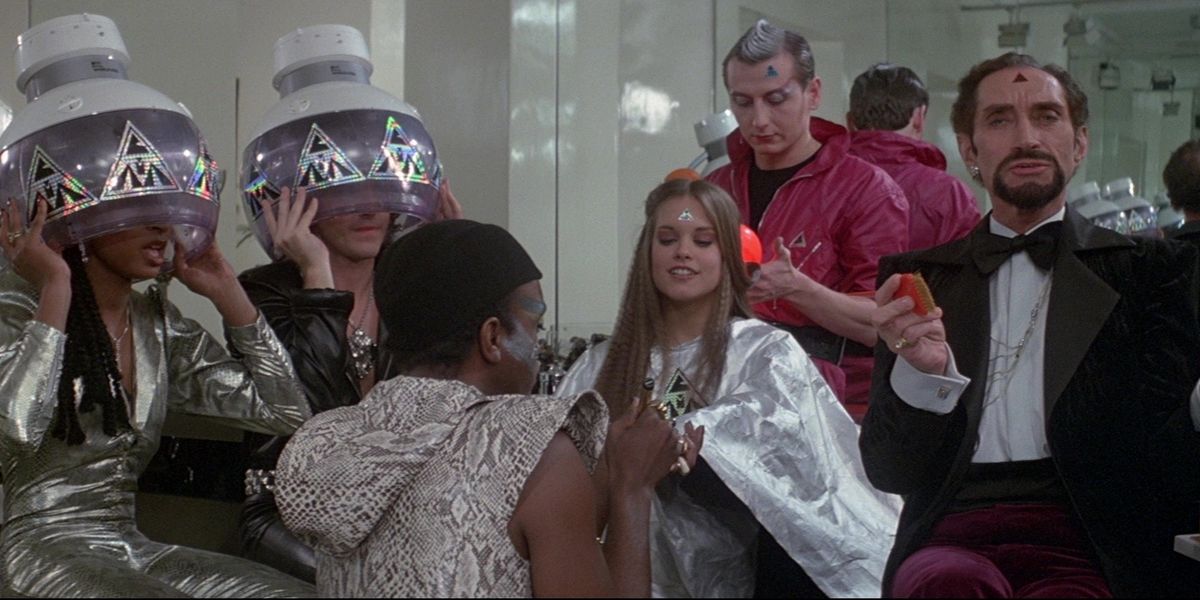Savoring the schlock, one terrible film at a time

"Mandy"
Produced by SpectreVision

"Mandy"
Since Christmas I have watched about 200 of the worst movies I could find. Thanks to the wonders of streaming, the supply of horrible films is, apparently, inexhaustible.
A note on methodology: I relied heavily on Rifftrax, an outfit that does the hard work of digging up these relics and offers them accompanied by what they call “riffing,” meaning they crack jokes.
The danger here is concentrating on the commentary and not the movies. Here at The Lakeville Journal’s Bad Cinema Desk, we write our own jokes.
So when feasible, I found the straight version of a flick Rifftrax covers.
Free-with-ads services such as Tubi, Freevee, and Plex have vast libraries of cruddy stuff, so it’s not that hard to track these things down.
But sometimes it was just simpler to go with Rifftrax and do my best to avoid swiping their gags.
Here are five awful movies that got my attention, for all the wrong reasons.
“Mandy” (2018): Psychedelic pshocker with the always-entertaining Nicolas Cage doing battle against a cult of weirdos whose leader (Linus Roache) seems to think he’s a cross between Jesus and Charlie Manson, with a little Jon Anderson (of Yes) thrown in for seasoning.
The weirdos are in cahoots with a gang of mutant bikers, and everybody’s drinking down this sludgy LSD specially created for them by the Chemist because, A) he doesn’t like them, and B) he’s got a tiger.
Kung fu with chainsaws, medieval weapons and bare fists. Eyeball-popping. Barbed wire. Hallucinations galore. King Crimson music. Custom vans. About 40 gallons of blood. Dorm room theology. And Cage in his skivvies, for maximum horror.
“Fungicide” (2002): This could be called “outsider cinema.” It could also be called “amateurish dreck.” Both descriptions are correct.
A mad scientist, an ex-military guy with issues, a jort-wearing tough guy from Philly and a real estate dork all show up at a rustic bed and breakfast.
The mad scientist has done something to the mushrooms so the spores are floating around creating killer mushrooms and the world is gonna end. I think that’s the gist of it. It’s hard to tell. The sound is kinda muddy.
What makes this shine are the killer mushrooms. There are three types: Mushrooms with teeth that are about 2 feet tall; man-sized mushrooms (no teeth); and unconvincing computer mushrooms.
Mushroom attack cam. Real estate broker chewed by mushrooms. Excellent stick fights between cast members and the big mushrooms. The slowest martial arts kicks ever captured on someone’s aunt’s camcorder. Mad scientist who would steal the show if there was a show to steal. Fascinating in its way. However, you may lose IQ points by watching this.

“Miami Connection” (1987): Also outsider cinema, in the sense that it really wants to be inside.
This flick centers around the guys in Dragon Sound, a rock band that made me long for the hard-hitting sounds of Journey or a tape of seals giving birth, whichever is easier to round up.
The Dragon Sound members study tae kwon do with the rhythm guitarist, Mark, and they need it because they get mixed up with a cocaine-dealing bunch of ninja-type bad guys. Also Mark’s not much of a guitarist.
The flick’s got a “Scooby-Doo” or “Archies” feel to it, marred somewhat by the star’s inability to speak English.
The music sequences would be unbelievable…except they are indistinguishable from rock videos of the era. So if the hard work of dozens of professional filmmakers and musicians can be duplicated for about 10 cents on the dollar by a bunch of complete amateurs, that says something. Something profound. And if you give me a minute I’ll remember what it is.
“Radical Jack” (2000): Starring Mr. Achy Breaky his ownself, Billy Ray Cyrus, as Jack, ex-CIA, seeker of justice and proud owner of the most spectacular mullet haircut in world history.
Jack blows into a small Vermont town and gets tangled up in an arms-dealing racket. I know that when I’m in the market for a rocket-propelled grenade launcher or some other handy item, I always think “Vermont.”
Here I must bow in tribute to Rifftrax for the vocal stylings during the sponge bath scene.
Elsewhere, you will be as pleased as I was when the son of the bad guy gets it right in the pleated Dockers. In these lax, postmodern times, crimes against style are so rarely punished in public.

“The Apple” (1980): Saving the absolute worst for last, this is a sci-fi rock musical, written and directed by Menahem Golan.
The story is that something called the BIM is coming, and a whole mob of freaks in shiny underwear have to get ready. Meanwhile this guy Alphie wants to rescue this girl Bibi from the BIM and go live in a field with the hippies.
It’s difficult to describe this adequately, so let’s just go with “bonkers,” which was how Falls Village’s Garth Kobal summed it up in a recent discussion of the trashy and ephemeral.
The high point is a musical number, “Coming.”
I used to think that Donna Summer’s 1975 disco hit “Love to Love You Baby” was the last word in sex songs. I mean, it’s about 20 minutes of moaning over a relentless beat.
But next to “Coming,” Summer’s effort sounds like a Gregorian chant.
The other high point is the end. Well, near the end.
There is an honest-to-God deus ex machina. Literally. A guy in a glowing white suit who gets out of a glowing white Rolls Royce in the sky to lead the hippies to Paradise.
And it’s not John Lennon.
Note: Many Rifftrax flicks (and predecessor “Mystery Science Theater 3000”) are available on the above-mentioned streaming services. For the uninitiated, watching a riffed version is a safe way to enter the world of Bad Cinema. Only advanced viewers should attempt the original versions, due to the very real possibility of irreparable brain damage.
The Torrington Transfer Station, where the Northwest Resource Recovery Authority plans to expand operations using a $350,000 state grant.
TORRINGTON — The Northwest Resource Recovery Authority, a public entity formed this year to preserve municipal control over trash and recycling services in northwest Connecticut, has been awarded $350,000 in grant funds to develop and expand its operations.
The funding comes from the Department of Energy and Environmental Protection via its Sustainable Materials Management grant program. It is intended to help the NRRA establish operations at the Torrington Transfer Station as well as support regional education, transportation, hauler registration and partnerships with other authorities.
Founded by the City of Torrington in May 2025, the NRRA was established to oversee regional municipal solid waste management. Its creation followed a $3.25 million offer by USA Waste & Recycling to purchase the Torrington Transfer Station — a sale that would have privatized trash services in the region.
The proposed sale was initially approved by the MIRA Dissolution Authority, the entity responsible for dissolving the state’s former Materials Innovation and Recycling Authority, which owned the Transfer Station at the time. Before the transaction could close, the state intervened and directed that the facility’s operating permit be assigned to the NRRA to preserve a publicly controlled alternative.
MIRA has since dissolved, and the Transfer Station is currently operated by the state Department of Administrative Services. Many towns in northwest Connecticut have expressed interest in joining the NRRA. As of December, Torrington and Goshen were the only two municipalities in the authority.
At the Dec. 11 meeting of the Northwest Hills Council of Governments (COG) — a regional planning body representing 21 municipalities in northwest Connecticut — Director of Community and Economic Development Rista Malanca encouraged more towns to sign on.
“We need towns to join the Northwest Resource Recovery Authority to show your support, show this is what you want to do,” Malanca said.
Salisbury First Selectman Curtis Rand said his municipality is planning a town meeting in January to vote on a resolution to join the NRRA. Cornwall’s Board of Selectmen recently discussed scheduling a town meeting in the winter for the same purpose. Sharon, Falls Village and North Canaan have also expressed continued interest in pursuing a public option.
Kent is the northernmost member of the Housatonic Resource Recovery Authority, a regional solid waste authority representing 14 municipalities stretching south to Ridgefield. COG towns expressed interest in joining HRRA in 2024, but they were denied and set out to develop the NRRA.
“We also have been having conversations with the Capital Region Council of Governments and the Naugatuck Valley Council of Governments to think about how we can use existing resources, maybe some of these grant funds, to bring in shared resources or shared staffing that will help with some of the recycling coordinating efforts,” Malanca said.
With grant funds secured, NRRA aims to grow to a point that it can take over operations at Torrington Transfer Station to serve as a regional hauling hub. What happens to the trash after that has yet to be determined. Currently, it is being shipped to a landfill out of state. The existing municipal refuse hauling contracts that were established with the state expire in 2027.
The Salisbury Winter Sports Association (SWSA) will host its annual Junior Jump Camp, a two-day introduction to ski jumping, on Saturday and Sunday, Dec. 27 and 28, from 9 a.m. to 2 p.m. at Satre Hill in Salisbury.
The camp is open to children ages 7 and up and focuses on teaching the basics of ski jumping, with an emphasis on safety, balance and control, using SWSA’s smallest hill. No prior experience is required.
The cost is $50 per child and includes instruction and lunch on both days. For more information or to register, visit www.skireg.com/swsa-camp or email info@jumpfest.org
Jesse Bunce, first selectman of North Canaan.
LITCHFIELD — The Northwest Hills Council of Governments welcomed six newly elected municipal leaders Thursday, Dec. 11, at its first meeting following the 2025 municipal elections.
The council — a regional planning body representing 21 towns in northwest Connecticut — coordinates transportation, emergency planning, housing, economic development and other shared municipal services.
Barkhamsted First Selectman Meaghan Cook, Goshen First Selectman Seth Breakell, Kent First Selectman Eric Epstein, Norfolk First Selectman Henry Tirrell, North Canaan First Selectman Jesse Bunce and Torrington Mayor Molly Spino were each elected to their post in November.
They filled the seats of their predecessors on the COG, who were each given a toast of appreciation: Nick Lukiwsky (Barkhamsted), Todd Carusillo (Goshen), Marty Lindenmeyer (Kent), Matt Riiska (Norfolk), Brian Ohler (North Canaan) and Elinor Carbone (Torrington).
COG Executive Director Rob Phillips said the outgoing members were given a going away mug that read “You’re living the dream still.” Members voted to appoint Warren First Selectman Greg LaCava to fill a vacancy on the Council’s Executive Committee. COG members voted by paper ballot, and LaCava defeated Burlington First Selectman Doug Thompson for the vacant seat.
Ryan Segalla takes a fadeaway shot over a defender.
FALLS VILLAGE — Housatonic Valley Regional High School’s boys basketball team defeated Pine Plains High School 60-22 in a scrimmage Tuesday, Dec. 9. The non-league preseason game gave both sides an opportunity to run the court ahead of the 2025-26 varsity season.
HVRHS’s senior-heavy roster played with power and poise. The boys pulled ahead early and kept their foot on the gas through to the end.
By halftime the score was 33-8. Junior varsity players subbed in for the second half, but not before the starters got some in-game dunk practice. By the end Housatonic totaled 60 points to Pine Plains’ 22.

Nick Crodelle led the Mountaineers offensively with 13 points. Anthony Labbadia and Wyatt Bayer scored nine points each. Anthony Foley scored eight points. Owen Riemer and Ryan Segalla each scored seven points. Peyton Bushnell hit a three-pointer. Jaxon Visockis and Henry Berry each scored two points.
HVRHS begins Berkshire League competition on the road at Nonnewaug High School Tuesday, Dec. 16, with a 6 p.m. tip off.

